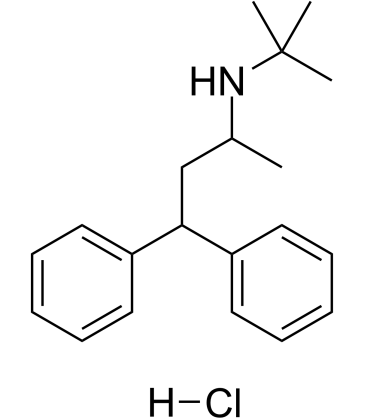Terodiline hydrochloride

Terodiline hydrochloride structure
|
Common Name | Terodiline hydrochloride | ||
|---|---|---|---|---|
| CAS Number | 7082-21-5 | Molecular Weight | 317.89600 | |
| Density | N/A | Boiling Point | 390.9ºC at 760 mmHg | |
| Molecular Formula | C20H28ClN | Melting Point | N/A | |
| MSDS | USA | Flash Point | 168.9ºC | |
| Symbol |


GHS07, GHS09 |
Signal Word | Warning | |
Use of Terodiline hydrochlorideTerodiline hydrochloride is an M1-selective muscarinic receptor (mAChR) antagonist with Kbs of 15, 160, 280, and 198 nM in rabbit vas deferens (M1), atria (M2), bladder (M3) and ileal muscle (M3), respectively. Terodiline hydrochloride also is a Ca2+ blocker. Terodiline hydrochloride acts as a treatment for urinary frequency and urge incontinence[1]. |
| Name | N-tert-butyl-4,4-diphenylbutan-2-amine,hydrochloride |
|---|---|
| Synonym | More Synonyms |
| Description | Terodiline hydrochloride is an M1-selective muscarinic receptor (mAChR) antagonist with Kbs of 15, 160, 280, and 198 nM in rabbit vas deferens (M1), atria (M2), bladder (M3) and ileal muscle (M3), respectively. Terodiline hydrochloride also is a Ca2+ blocker. Terodiline hydrochloride acts as a treatment for urinary frequency and urge incontinence[1]. |
|---|---|
| Related Catalog | |
| Target |
mAChR[1] Ca2+ channel[1] |
| In Vivo | Terodiline (80 mg/kg; S.C.) is equipotent in inhibiting intravesical bladder pressure and carbachol-induced salivary secretion (ID50= 24 and 35 mg/kg, respectively), and in increasing pupil diameter (ED50=59 mg/kg)[1]. Animal Model: Fmale or male Hartley guinea pigs (200-600 g)[1] Dosage: 80 mg/kg Administration: Administered S.C. Result: Yielded an ID50 of 24±6 mg/kg. Higher doses were Iethal. |
| References |
| Boiling Point | 390.9ºC at 760 mmHg |
|---|---|
| Molecular Formula | C20H28ClN |
| Molecular Weight | 317.89600 |
| Flash Point | 168.9ºC |
| Exact Mass | 317.19100 |
| PSA | 12.03000 |
| LogP | 6.17810 |
| Symbol |


GHS07, GHS09 |
|---|---|
| Signal Word | Warning |
| Hazard Statements | H302-H319-H400 |
| Precautionary Statements | P273-P305 + P351 + P338 |
| Personal Protective Equipment | dust mask type N95 (US);Eyeshields;Faceshields;Gloves |
| Hazard Codes | Xn,N |
| Risk Phrases | 22-36-50 |
| RIDADR | UN 3077 9/PG 3 |
| RTECS | UH9970000 |
|
Action potentials, contraction, and membrane currents in guinea pig ventricular preparations treated with the antispasmodic agent terodiline.
J. Pharmacol. Exp. Ther. 290(3) , 1417-26, (1999) Terodiline was widely prescribed for urinary incontinence before reports of adverse cardiac effects that included bradycardia, QT lengthening, and ventricular tachyarrhythmia. The present study on gui... |
|
|
Comparison of the effects of NS-21 and terodiline on the QTc interval in dogs.
Gen. Pharmacol. 30(1) , 137-42, (1998) 1. NS-21 [(+/-)-4-diethylamino-1,1-dimethylbut-2-yn-1-yl 2-cyclohexyl-2-hydroxy-2-phenylacetate monohydrochloride monohydrate], its active metabolite, RCC-36, and terodiline, are mixed anticholinergic... |
|
|
CYP2D6 and CYP2C19 genotypes of patients with terodiline cardiotoxicity identified through the yellow card system.
Br. J. Clin. Pharmacol. 50(1) , 77-80, (2000) Terodiline has concentration dependent QT prolonging effects and thus the potential for cardiotoxicity. Pharmacogenetic variation in terodiline metabolism could be responsible for cardiotoxicity. We s... |
| Propylamine,N-tert-butyl-1-methyl-3,3-diphenyl-,hydrochloride |
| N-tert-Butyl-1-methyl-3,3-diphenylpropylamine hydrochloride |
| TERODILINE HYDROCHLORIDE |
| Bicor |
| N-t-Butyl-1-methyl-3,3-diphenylpropylamine hydrochloride |
| Terodiline chloride |
| TD-758 |
| Terodiline HCl |